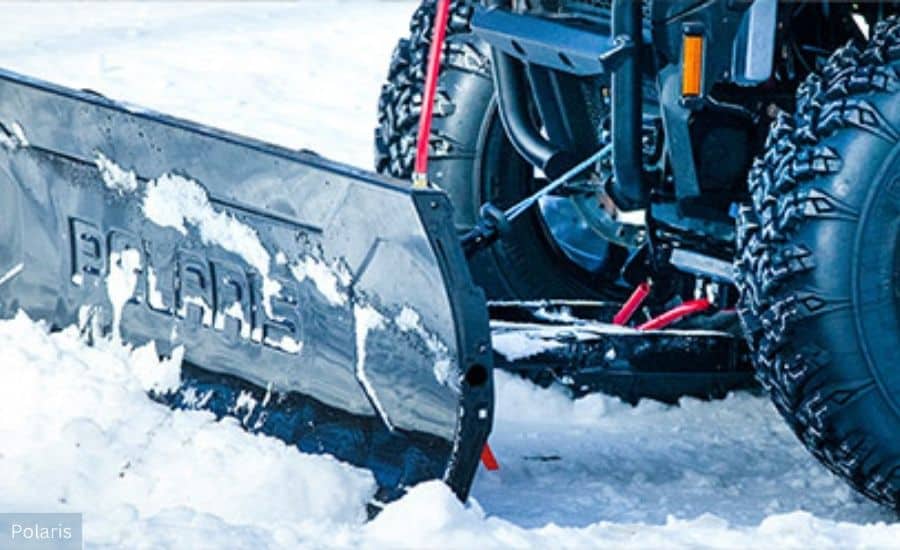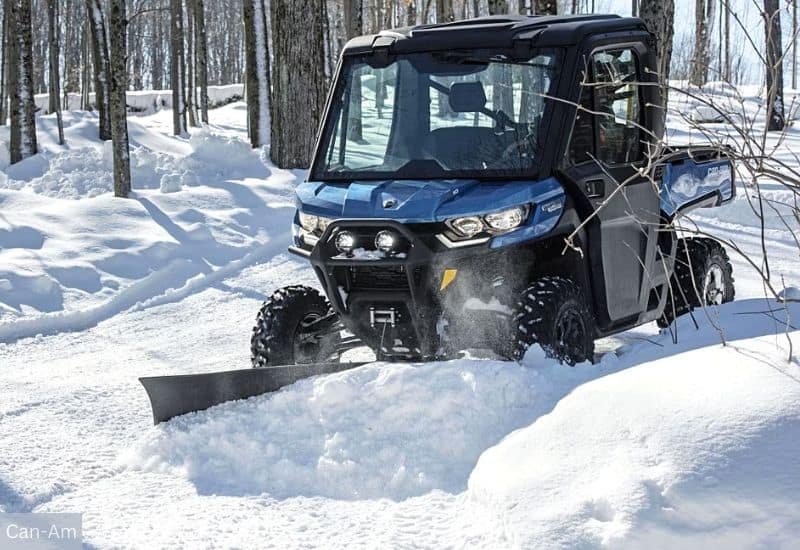For those living in snowy regions, removing the white stuff from driveways and paths quickly becomes a time-consuming cold-weather chore.
Shoveling by hand takes forever and can strain your back while using an under-powered ATV with a plow can struggle to clear heavy, wet snow.
So what’s the best solution?
A utility task vehicle (UTV) with a snow plow attachment can make quick work of wintertime snow removal.
But are UTVs really ideal for plowing? What should you consider before using one? Which plow setup works best?
We’ll answer all these questions in this blog post, plus, much more.
So let’s “plow through” everything you need to know about using UTVs for clearing snow. (Sorry for the pun.)
UTVs & Snow Removal
First, what exactly is a UTV? UTVs are off-road vehicles with 2-4 seats, a cargo bed, and a powerful engine.
Unlike recreational ATVs designed primarily for trails, UTVs are built for utility purposes like hauling gear, towing, and yes, plowing snow.
Key features that make UTVs useful for snow removal:
- Powerful engines, usually over 100hp.
- Ample torque with low-end gearing for extra power and traction.
- 1,500+ pound towing and haul capacities.
- Dump beds, flatbeds, and built-in attachment points for plows and other accessories.
- 2WD, 4WD, or 6WD drivetrains with locking differentials for traction.
- Larger tires with aggressive tread patterns for better traction and grip.
- Available cabs to enclose and protect the driver. Some even offer heating.
Polaris Rangers, Honda Pioneers, Can-Am Defenders, and John Deere Gators are among the most popular UTV models used for snow plowing.
Why UTVs Excel at Removing Snow

Compared to using ATVs or truck plows, UTVs offer clear advantages when equipped properly for blasting through wintery mixes.
More Power & Traction
UTVs have sturdier drivetrains, chassis, transmissions, and engines over recreational ATVs built for lighter trail use.
Their 1500+ pound tow/haul capacities allow UTVs to push heavy plow blades through dense snow that would overwhelm most ATVs.
Meanwhile, UTVs offer better maneuverability and traction over larger trucks with their shorter wheelbases and locking differentials that keep you moving forward.
Their lower centers of gravity also make them less prone to getting stuck and provide increased stability when navigating through slippery conditions.
Ability to Mount Wide Plows
Unlike ATVs limited by smaller racks and frames, UTVs can be equipped with much larger and heavier-duty plows.
Their wider stances and stable chassis can often handle V-plows spanning 6+ feet wide to move major snow.
Comfortable Cabs Available
UTVs like the Polaris Ranger offer enclosed, climate-controlled cabs to take on winter winds, snow, and cold while plowing.
Cab comfort features often include:
- Heated Interiors
- Windshield Wipers
- Defrost Vents
- Full Doors With Functional Windows
UTV cabs bring welcome warmth and protection from the elements when working for hours plowing snow.
Better Handling of Plow Weight
Between heavy-duty snow plow blades and mounts, UTVs can take on 500+ pounds in front equipment weight without compromising steering or handling.
Components like power steering, large tires with aggressive tread, 14+ inch ground clearance, and custom snow tracks on some models keep them planted and moving forward confidently even in snowy conditions.
What To Consider Before Plowing With a UTV
While UTVs make quick work of wintertime snow removal, they require some additional considerations before you hit the snow-laden driveway, which we’ve outlined below.
Operating Weight Capacity
Even compact snow under a foot can pile hundreds of pounds onto UTV plows.
So the vehicle’s operating weight and load capacities should exceed this minimum by a safe margin.
Small side-by-sides with low-end capacities of under 500 pounds will struggle compared to larger more robust side-by-sides with capacities greater than 2,000 pounds.
Because of this, if you’re planning on doing more than light-duty plowing, you should opt for a larger more powerful UTV.
Matching the Transmission for Plowing
Frequent shifting between forward and reverse while plowing demands a lot from drivetrain components.
So rather than a manual clutch, most owners prefer 2/4WD CVT transmission models, as continuously variable transmissions can more easily change through a continuous range of gears.
This prevents overheating standard gearboxes not built for continual directional changes under load.
Drivetrain: 2WD or 4WD
While 2WD works well for flat terrain, plowing uneven ground, slopes, or deeply drifted snow demands 4WD or 6WD models.
Their locking differentials supply constant power to all wheels – unlike auto 4WD, which can lose traction.
Differential locks are especially helpful when maneuvering plow blades through thick, heavy snow.
Winches – Essential UTV Snow Plow Accessory
A winch with a rated line pull exceeding the gross vehicle weight of the side-by-side is essential safety gear when plowing snow.
Even with 4WD, UTVs can become immobilized in tall snow. A reliable winch provides self-recovery when stuck so you can keep plowing.
Some of the best winches for UTVs are made by Warn, SuperATV, MotoAlliance, QuadBoss, and KFI.
Full Enclosed Functional Cabs
For multi-hour snow plowing sessions, UTV comfort features like doors, comfy seats, and climate control, make a huge difference compared to open cockpits.
Most UTV manufacturers like Polaris, Can-Am, and Honda offer models with enclosed cabs that let you block out the cold and snow for ultimate comfort when plowing.
How To Pick the Right UTV Snow Plow

With so many plow options and UTV manufacturers, finding the best snow removal setup can seem overwhelming.
But understanding key considerations when comparing UTV snow plows simplifies the selection process.
V-Plow vs. Straight Blade
The two main types of plows are the V-plow and the straight blade, each with distinct advantages and ideal use cases.
A V-plow is characterized by its distinctive V-shaped design, which allows the operator to tackle heavy and deep snow more effectively. The angled blades cut through dense snow, breaking it up and pushing it to the sides.
In addition, the V-plow’s design allows it to navigate around obstacles more easily, making it better suited for driveways and spaces with parked cars or landscaping features.
Straight-blade plows are exactly what their name implies – a single, straight blade used to push snow forward or to the side.
This simplicity offers some advantages, as straight blade plows are generally more straightforward to operate and maintain. They are often lighter in weight and less complex mechanically, which can make them a cost-effective choice for those who don’t need the additional functionality of a V-plow.
Straight blades are ideal for clearing smaller volumes of snow and are excellent for flat, open spaces like parking lots or long driveways where maneuvering around obstacles is less of a concern.
Manual vs. Hydraulic Plow Lift
Manual lift plows use a winch with steel cables to angle the blade left or right and to raise and lower the blade. They are simple, durable, and affordable but they do require you to leave your seat and bear the cold.
On the other hand, hydraulic lifts angle or raise blades using electric pumps and hydraulic power.
This allows easier control without leaving the driver’s seat. Much more convenient but pricier.
Plow Angle
When selecting a snowplow, it’s important to consider the range of motion, especially the ability to angle the plow to efficiently direct the snow off to the sides.
Look for a snowplow that offers at least a 30-degree left or right angle to plow snow efficiently.
Blade Material
Snow plow blades are typically either made from steel or polymers.
Steel blades withstand abuse on gravel and asphalt driveways. But they can damage delicate surfaces like pavers.
Softer polymer plows protect decorative finishes. However, they wear faster on abrasive surfaces like concrete and asphalt.
Size & Width Considerations
Six to eight-foot-wide V-plows clear paths in fewer passes compared to smaller plows and blades.
This increased width allows for a broader swath of snow to be moved, which is particularly useful for larger properties or longer driveways.
Just be sure your UTV has the frame strength, weight capacity, and drivetrain to push weighty eight-foot blades.
UTV Snowplow Brands
Popular snowplow manufacturers like KFI, Warn, Koplin, MotoAlliance, and SnowEx offer a range of plowing equipment suited to various needs, from residential driveways to commercial lots.
These snowplow brands also provide different models that can be tailored to the specific needs of the user, such as different blade materials like stainless steel or poly, various plow widths, and options for manual or hydraulic adjustments.
Additional Handy UTV Attachments for Snow Plowing
When gearing up for the snowy season, having the right equipment is critical for quick and efficient snow removal.
While a robust UTV with a quality plow blade is a great start, numerous additional attachments can significantly enhance your plowing capabilities.
- Tire Chains – Improve traction with tire chains that wrap the wheels of 2WD and 4WD UTVs. Don’t forget to ensure that the chains specifically fit your machine’s tires, as they come in many sizes.
- Snow Deflectors – Deflectors or “tunnels” attach above the plow to direct the stream of snow rolling off the blades to the sides for optimal snow relocation.
- Plow Markers – Markers help you gauge the plow’s position and location, so you avoid damaging lawn edges or other obstacles.
- LED Lights – Additional LED floodlights can help to illuminate your plowing path when working in the dark or heavy snowfall.
UTV Snow Plowing Tips & Techniques
Plowing snow successfully with UTVs relies on more than just good equipment, as it also relies on good technique.
These proven plowing tips lead to better and faster snow removal:
- Take It Slow – Rushing while plowing leads to accidents, breakdowns, and unfinished work. Carefully assess the terrain first without the plow, looking for hidden obstacles, and then slowly and systematically work to remove the snow.
- Multiple Passes are OK – Problem or difficult areas may require two passes.
- Use Low Gear – Keep UTVs in low gear when plowing for maximum torque, push power, and traction. Added torque prevents bogging down in deep snow.
- Angle Blade Gradually -Sudden angling of the plow blade left or right can torque the chassis and overload components. Instead, incrementally roll blade angles to relocate snow off to the sides without abrupt force.
- Pattern Plow Path – Plow area perimeter first, then work inward sections methodically. Serpentine back and forth when plowing for steady progress so snow builds uniformly off the pushing path.
- Carry Emergency Supplies – Pack tow straps, jumper cables, food, water, gloves, and a folding shovel in case your UTV becomes stuck. Having backup supplies provides safety.
- Consider a Winter Cab – For sub-zero snow plowing, UTV winter cab enclosures with heat, windshield wipers, and doors provide lots of comfort and visibility benefits. Brands like Side X Side Enclosures offer complete cab kits tailored to popular UTVs.
The Bottom Line – Are UTVs Ideal for Plowing Snow?

In summary – yes – UTVs can serve as outstanding snow plow machines.
Their powerful drivetrains, increased stability, and ability to mount wide V-plows make UTVs hard workers for clearing snow efficiently and effectively.
For home and light commercial use, UTVs like the Polaris Ranger paired with quality plow components are becoming the preferred choice over single-seat ATVs and outdated plow trucks.
So don’t dread shoveling driveways or dragging out the snowblower this winter.
Instead, outfit a capable UTV with an adjustable plow system built to take on Old Man Winter’s worst.
Then watch those snow piles disappear as quickly as they arrived, leaving behind clear pavement ready for business.
Just be sure to realistically match the UTV’s vehicle capacities and drivetrain strengths to the intended area to plow and winter conditions.
Recent Posts
Is Can-Am Better Than Polaris? This question has been debated for years, sparking intense debates in off-road communities and showrooms. As two titans in the world of ATVs and UTVs, Can-Am and...
Whether you're an adult looking for a new adventure or introducing your kids to the sport, finding the best beginner dirt bike is crucial to kick-start your off-road journey on the right...

